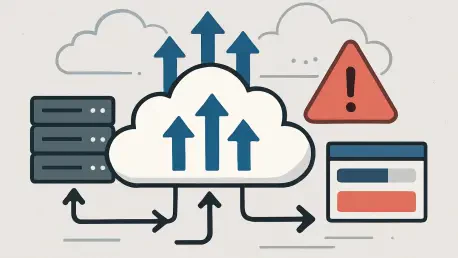As the digital landscape continues to evolve at a breakneck pace, the three titans of cloud computing—Microsoft Azure, Google Cloud, and Amazon Web Services (AWS)—find themselves grappling with an unexpected hurdle despite their staggering financial success. These industry leaders, often referred to as the Big 3, have reported remarkable revenue growth, fueled by the relentless demand for cloud services amid widespread digital transformation and the rise of artificial intelligence (AI) workloads. However, their ability to fully capitalize on this demand is being stifled by significant capacity constraints, with data center and infrastructure limitations emerging as critical bottlenecks. This situation raises pressing questions about how these hyperscalers can sustain their momentum in a market that shows no signs of slowing down. The tension between soaring demand and restricted supply paints a complex picture of an industry at a pivotal moment, balancing immense opportunity with operational challenges.
Surging Demand Meets Infrastructure Roadblocks
The cloud computing sector is experiencing unprecedented growth, with the Big 3 posting impressive year-over-year revenue increases that underscore the market’s vitality. Google Cloud achieved a striking 32% rise, reaching $13.62 billion, while Microsoft Azure recorded a 27% uptick to $46.7 billion, and AWS reported a 16.9% increase to $29.3 billion. Industry analysts point to the cloud market nearing a $100 billion quarterly milestone, with annual growth rates hovering around 25%, a trend expected to persist above 20% for at least the next five years. This robust expansion is driven by traditional cloud migrations, cloud-native applications, and burgeoning AI workloads. Yet, despite these achievements, the inability to scale infrastructure fast enough to match demand has become a shared pain point. Each company has acknowledged that capacity shortages are curbing their potential to serve more customers and generate additional revenue, highlighting a critical gap between market needs and operational reality.
Beyond the headline numbers, the root of these constraints lies in the physical and logistical challenges of expanding data center capacity at the required pace. The surge in demand, particularly from AI-driven applications requiring immense computational power, has outstripped the current infrastructure capabilities of even these well-resourced giants. Microsoft, for instance, has added over 2 gigawatts of capacity in the past year but still anticipates constraints through the first half of fiscal 2026. Similarly, AWS has noted that its inability to meet all customer needs directly impacts revenue potential, while Google Cloud is racing to close the gap through significant investments. This scenario reveals a stark reality: while the appetite for cloud services continues to grow, the physical expansion of servers, power, and cooling systems cannot keep up with the speed of digital transformation. The industry faces a defining challenge in aligning infrastructure growth with market expectations.
Strategic Investments to Overcome Limitations
In response to these capacity hurdles, the Big 3 are committing unprecedented levels of capital expenditure (CapEx) to bolster their infrastructure and secure future growth. Google Cloud has raised its CapEx guidance by $10 billion to a staggering $85 billion, focusing heavily on cloud infrastructure and AI capabilities, as emphasized by its leadership. Microsoft is projecting over $30 billion in CapEx for a single quarter, aiming to address immediate shortages while preparing for sustained demand. AWS, meanwhile, is channeling investments into both capacity expansion and innovative AI solutions to maximize efficiency within existing constraints. These aggressive financial commitments signal a clear intent to overcome supply limitations through rapid scaling of data centers and advanced technologies. However, the timeline for these investments to yield results remains a concern, as building and operationalizing new facilities is a complex, time-intensive process.
Alongside infrastructure expansion, the integration of AI as a growth driver is shaping the strategic priorities of these hyperscalers. Google Cloud attributes much of its success to AI-optimized data centers and offerings like TPUs and GPUs, tailored for high-performance computing. AWS is innovating with AI-specific hardware, such as the Trainium2 chip, and new services designed for AI agent deployment, while Microsoft highlights AI workloads as a cornerstone of its expansion alongside large-scale cloud migration projects. This focus on AI not only drives demand but also necessitates specialized infrastructure, further complicating capacity planning. The convergence of traditional cloud services with cutting-edge AI applications underscores a broader industry shift, where technological advancement and physical scalability must go hand in hand. As these companies pour resources into both areas, the race to balance innovation with operational capacity defines their current trajectory.
Long-Term Optimism Amid Current Challenges
Despite the immediate obstacles posed by capacity constraints, executives from the Big 3 remain steadfastly optimistic about the long-term prospects of the cloud market. Microsoft’s leadership has described the cloud migration journey as being only halfway through, suggesting vast untapped potential as businesses continue to shift from on-premises systems. AWS echoes this sentiment, noting that 85-90% of global IT spending still resides outside the cloud, forecasting a monumental transition over the next decade or more. Google Cloud similarly views the current constraints as temporary hurdles in a market poised for exponential growth. This shared confidence rests on the belief that ongoing investments and strategic focus on scalability will eventually bridge the gap between demand and supply, positioning these companies to capture a larger share of the digital economy as it evolves.
Reflecting on the broader implications, the sustained high growth rates and proactive strategies adopted by these hyperscalers point to a future where capacity challenges are surmountable. The emphasis on both infrastructure and innovation, particularly in AI, indicates a dual approach to addressing today’s limitations while preparing for tomorrow’s demands. As the industry progresses, the lessons learned from navigating these constraints will likely shape how cloud providers plan and execute expansion in the years ahead. The focus now shifts to monitoring how quickly these massive investments translate into tangible capacity increases and whether the Big 3 can maintain their competitive edge in a rapidly transforming market. This ongoing saga of growth versus limitation offers a compelling narrative for stakeholders watching the cloud computing space unfold.









